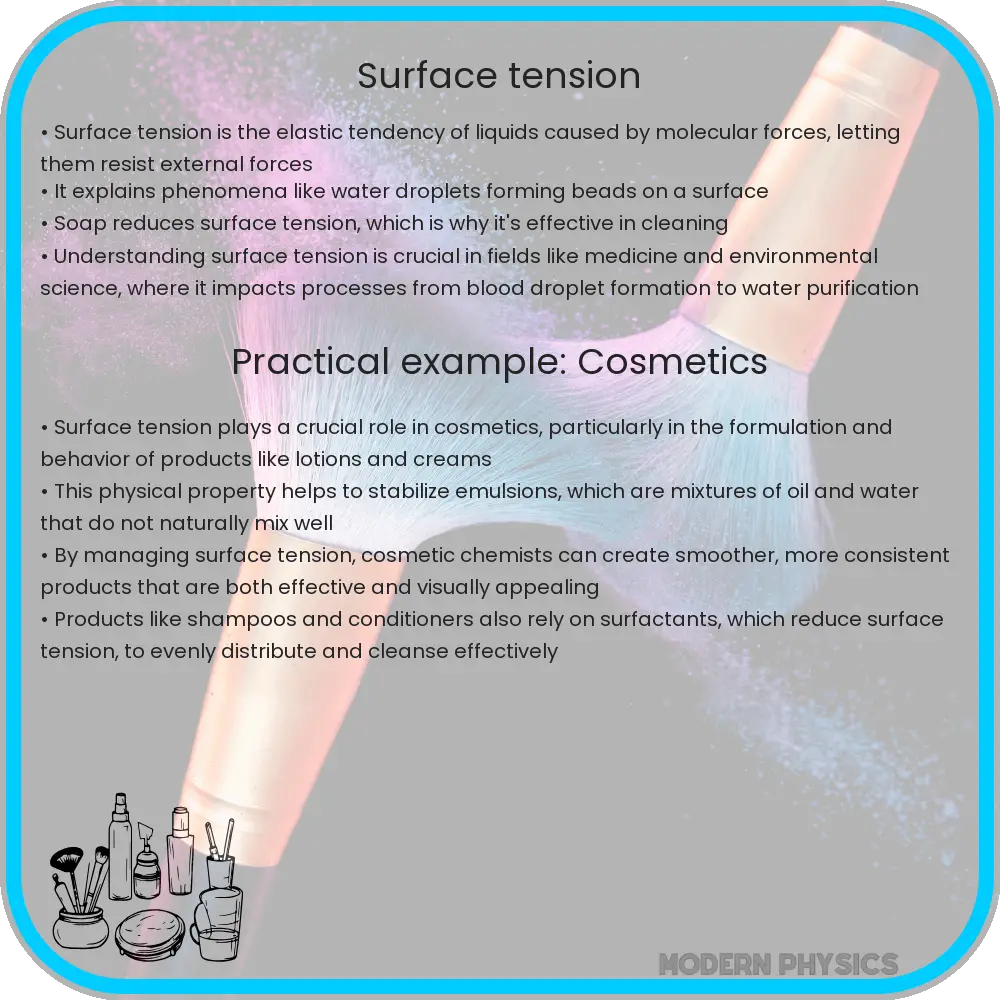Explore the essentials of surface tension in fluid dynamics, covering its causes, effects, and applications in nature and technology.

Understanding Surface Tension in Fluid Dynamics
Surface tension is a fundamental concept in fluid dynamics, playing a crucial role in phenomena ranging from the floating of objects on water to the formation of droplets. It emerges from the cohesive forces between liquid molecules, which are particularly significant at the liquid-air interface. This article delves into the principles of surface tension, exploring its causes, effects, and the balance of forces involved.
The Science Behind Surface Tension
At the heart of surface tension lies molecular cohesion. In liquids like water, molecules are attracted to each other through forces such as hydrogen bonding. These cohesive forces are balanced in the bulk of the liquid. However, at the surface, molecules experience a net inward force since there are no liquid molecules above them. This imbalance creates a tendency for the surface to contract, minimizing the exposed surface area and resulting in a phenomenon we observe as surface tension.
Mathematical Representation of Surface Tension
Surface tension, denoted by the Greek letter gamma (γ), is quantified as the force per unit length acting along the liquid surface. It is expressed in Newtons per meter (N/m) or dynes per centimeter (dyn/cm). The formula for surface tension is:
γ = F/L
where F is the force exerted parallel to the surface and L is the length along which the force acts.
Role of Surface Tension in Fluid Behavior
Surface tension is pivotal in various fluid behaviors. It allows certain objects, even those denser than the fluid, to float or remain on the surface due to the force balance at the interface. This concept is crucial in understanding phenomena like the ability of water striders to walk on water surfaces or the formation of soap bubbles.
Measuring and Altering Surface Tension
Surface tension can be measured using methods like the capillary rise method or the drop weight method. It varies with temperature and the presence of surfactants – substances that reduce surface tension. Surfactants, such as soap, disrupt the cohesive forces among liquid molecules, thereby lowering the surface tension. This effect is utilized in numerous industrial and biological processes.
Applications and Implications of Surface Tension
Surface tension has wide-ranging applications across various fields. In engineering, it is vital in the design of fluid systems and devices, such as fuel injection systems in automobiles. In the medical field, understanding surface tension is crucial for developing drug delivery systems and respiratory treatments. Even in nature, surface tension plays a role in phenomena such as the formation of raindrops and the structure of biological membranes.
Surface Tension in Everyday Life
The effects of surface tension are not confined to scientific and industrial realms; they are observable in everyday life. From the way a drop of water beads up on a leaf to the formation of bubbles when washing dishes, surface tension is constantly at play. It also explains why water forms a meniscus in a glass tube, curving upwards or downwards depending on the interaction between the liquid and the surface.
Challenges and Future Research in Surface Tension
Despite its fundamental nature, surface tension continues to pose challenges in various research areas. Understanding and manipulating surface tension is key in advancing technologies like microfluidics, which operate at scales where surface tension dominates over other forces. Additionally, research into new surfactants and their environmental impact is ongoing, highlighting the balance between industrial needs and ecological considerations.
Conclusion
In conclusion, surface tension is a remarkable phenomenon that stems from the cohesive forces between molecules at the liquid-air interface. It influences a vast array of natural and technological processes, from the mundane to the complex. The study of surface tension not only enhances our understanding of fluid dynamics but also opens doors to innovative applications in various scientific and industrial fields. As research continues to unravel its mysteries, the potential for new discoveries and advancements remains vast, promising further insights into this intriguing aspect of fluid behavior.
